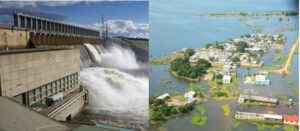Between September 15 and October, the Volta River Authority (VRA) conducted a “controlled spillage” of water from the Akosombo and Kpong Dams. This is the 11th since inauguration of the Akosombo Dam in 1965. The spillage submerged communities downstream. Media reports suggest that about 50,000 people were displaced, while homes, farms and livelihoods were washed away. This created an environmental and economic crisis, disrupted education and increased hardships for vulnerable individuals. Also, experts warned of a public health epidemic that could follow the flood disaster. Generally, the situation is described as a humanitarian crisis.

While the VRA and National Disaster Management Organisation argue that the spillage was a necessary measure to avert a catastrophic dam rupture, valid questions arise about the process – given its
consequences. It is worth noting that the VRA successfully managed higher water volumes (277ft in 2010), compared to 276ft this year. Furthermore, there are financial and engineering concerns about the cost associated with evacuating and resettling affected communities in modern Ghana, as opposed to employing advanced engineering techniques to divert excess water to the sea. Despite these important questions, this article primarily delves into the factors contributing to fluctuations in water levels in dams like Akosombo, Kpong and Weija, leading to spillage disasters in recent years.
Historical water level concerns
The operational water levels for the Akosombo Dam ranges between 240ft and 278ft. Deviations beyond these limits have serious implications for hydroelectric power supply and human lives. Historical data, such as research conducted by Eric Ocran in 2015, reveal that the lowest recorded water level occurred in 1966 (234ft), while the highest was noted in 2010 (277.54ft).
Although concerns exist regarding both low- and high-water levels, the prolonged focus has been on the lower values. This concern was substantiated by Eric Ocran’s work in 2015, which indicated a potential fall of levels below 226ft, which could cause all turbines in the dam to shut down. Several researches raised similar concerns about declining water volume in the dam. Beyond that, the Daily Graphic newspaper reported on a group of pastors who prayed at the dam site to avert a potential prolonged electrical power shortage due to low water levels.
In recent years, however, the situation has reversed and the dams are overflowing – and several factors may be accountable for this. Some include lower temperatures/evaporation, increased inflows from tributaries, and developments along river courses. Another might be reduced water consumption at the dam to construction of the Bui Dam and the installation of thermal plants.
Climate change as a significant factor
All the factors notwithstanding, a fundamental question could be whether climate variation is a primary contributory factor. According to the UN’s Intergovernmental Panel on Climate Change (IPCC), Climate Change is long-term shifts in temperatures and weather patterns caused by the prolonged accumulation of carbon dioxide (CO2) emissions in the atmosphere – and this results in more frequent and unpredictable extreme weather events.
The National Aeronautics and Space Administration (NASA) supports this perspective, through data from observations on ground, air and space, with computer models that changes in global land and ocean temperatures, rising sea levels and shifts in extreme weather patterns, such as hurricanes, heatwaves, floods and precipitation are associated with climate change.
Local impact of climate change
In a study from the year 2021, Frederick Ebert Stiftung Ghana found that Ghana experienced extreme weather events over the past five years, including severe droughts and heavy rainfall. These had devastating effects on agricultural workers and exposed significant vulnerabilities in infrastructure, public health and ecosystems. The World Bank Group’s Ghana Country Climate and Development Report 2022 warns of flooding and drought as consequences of climate change in the country, and advised government to establish early warning systems and safety nets for vulnerable communities.
Akosombo Dam case
Analysing the Akosombo Dam’s situation reveals a notable surge in water levels to about 276ft. This is a sharp contrast to the recent situation when the dam was at risk of drying up. Authorities attribute the surge to heavy rainfall, a claim supported by data from the Ghana Meteorological Agency. Aside from that, falling temperatures in the region have significantly reduced water loss from the dam due to reduced evaporation.
Conclusion: The case for climate change mitigation
The evidence strongly suggests that overflowing dams in Ghana are influenced by climate pressures. Urgent measures are required to mitigate the impact on vulnerable communities. There is therefore a need to invest in AI tools for remote sensing and satellite data for early detection of climate pressures and appropriate responses.
David is Head of Corporate Affairs, Pentecost University










